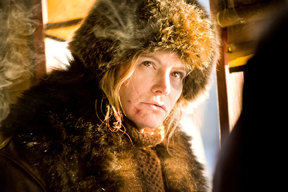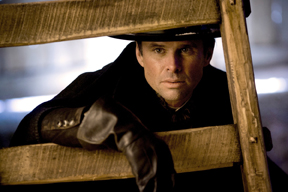![]() Let’s get the premise out of the way first, shall we? John Ruth “The Hangman” (Kurt Russell) is gonna take Daisy Domergue (Jennifer Jason Leigh, sporting a big black eye that is never explained but doesn’t has to be, to Red Rock, Wyoming, circa early 1870’s (give or take a few years). There she’s set to hang. He escorts her on a stagecoach through the wintry wilderness and, by chance, the coach encounters Marquis Warren (Samuel L. Jackson), a former Union major who killed as many white men as he could in the Civil War. He’s now a bounty hunter who needs a ride, and Ruth has room for one more. Begrudgingly, to say the least, Ruth lets him on. There’s another man who joins the stagecoach party, Chris Mannix (Walton Goggins in his first major Tarantino appearance, previous in a small role in Django Unchained). Mannix was also in the Civil War. However, a blizzard’s coming in these snowy hills and mountains, and luckily on the way to Red Rock there’s Minnie’s Haberdashery, with another group of men sheltering there. So what now for Ruth and Domergue and Warren and Mannix?
Let’s get the premise out of the way first, shall we? John Ruth “The Hangman” (Kurt Russell) is gonna take Daisy Domergue (Jennifer Jason Leigh, sporting a big black eye that is never explained but doesn’t has to be, to Red Rock, Wyoming, circa early 1870’s (give or take a few years). There she’s set to hang. He escorts her on a stagecoach through the wintry wilderness and, by chance, the coach encounters Marquis Warren (Samuel L. Jackson), a former Union major who killed as many white men as he could in the Civil War. He’s now a bounty hunter who needs a ride, and Ruth has room for one more. Begrudgingly, to say the least, Ruth lets him on. There’s another man who joins the stagecoach party, Chris Mannix (Walton Goggins in his first major Tarantino appearance, previous in a small role in Django Unchained). Mannix was also in the Civil War. However, a blizzard’s coming in these snowy hills and mountains, and luckily on the way to Red Rock there’s Minnie’s Haberdashery, with another group of men sheltering there. So what now for Ruth and Domergue and Warren and Mannix?
From this, in “The 8th Film by Quentin Tarantino” as it says before the title comes up, we get this filmmaker’s most elaborate film since Kill Bill As a stand-alone, it’s by far his longest in running time, even in the multiplex version coming out a week after the 70mm “roadshow” engagement, which includes an intermission. At the same time, it’s also one of his most intimate films. In press for the film, Tarantino has said repeatedly that he could easily have turned this material into a stage play either off-Broadway on a small 90-seat theater or in the biggest theater in town. Considering its technical aspect, he went for the film equivalent of the latter.
Tarantino is not one to be coy about who he “borrows” his cinematic material from, whether it’s obscure Spaghetti Westerns or the greatest films ever made, and here he is kind of borrowing from himself—in a way. The premise is unmistakably linked to John Carpenter’s The Thing, where Russell also stars as a man who knows “one of us is not who he says he is.” (Both are scored by the master of film compositions, Ennio Morricone). Tarantino’s own film Reservoir Dogs was also a naked homage in some ways to The Thing (which itself was a reimagining of the 1951 film by Tarantino’s idol, filmmaker Howard Hawks). The overriding notion is not being able to trust a single person you’re with, and who do you trust if everyone is a conniving SOB? Or are they?
The magnitude and power of The Hateful Eight is that Tarantino takes so much time so that you get to know everyone in that stagecoach before they even get to the haberdashery. (The snowbound nihilism reminds me, too, of Sergio Corbucci’s 1968 The Great Silence.) In all, the first part is around an hour of screen time, and then the haberdashery set piece takes up two hours, with the 70mm engagement separated by an intermission between Tarantino’s chapters three and four.
What about the other stranded guests at the Haberdashery once the stagecoach travelers arrives there? Tim Roth sports a “Cheerio” high-pitched British accent, and Michael Madsen plays the Quiet Cowboy type. Bruce Dern, who never gets up from his chair, still gives one of the best performances in a film dripping with awe-inspiring talent.
The most arresting personalities are Warren and Daisy. Some of this is attributable to the towering performances and in large part because Tarantino and cinematographer Bob Richardson spend time just capturing the two in little moments in the stagecoach. We get to see them think and how they react to those around them. Warren is someone who can talk and talk well (and watch for a particular monologue in chapter three, it’s the kind that will make you question if this or Pulp Fiction’s “Ezekiel 25:17” speech is more memorable), while Daisy is a feral creature, often spitting or laughing or getting tossed about, except for a moment where she gets hold of a guitar and sings in a rare down-time moment. This will be remembered as the year when Leigh sings and holds your attention here and (or very different reasons in Anomalisa.
The trust issue may also come down to an Agatha Christie-type of premise (a comparison made by many critics), but what so impresses me is that Tarantino made his own world here while still paying homage to Carpenter and Hawks and Leone. He can’t escape the latter with Morricone around. It’s not just Tarantino’s first original score done for a film, but it’s the first made by the composer for a western in 40 years and, believe me, it’s one of his finest.
Tarantino’s dialogue is dense, which may be daunting for some in the audience, as characters talk in his style of digressions and minutiae–though still built around characterizations and foreshadowing–and yet there are deeper themes about racism and what people take away from historical catastrophes (like the Civil War) and what shapes them in the aftermath.
It’s interesting to find out that it originally began (in novel form) as a sequel to Django Unchained, but Tarantino realized very soon into writing it that the story couldn’t have a “moral center,” as he put it. That’s the key thing when watching The Hateful Eight: it’s about a world where there is no morality, just mean sons of bitches. There’s the sense that you don’t know anyone and what you do is just as important as what you say. Oh, it should also be noted that the movie becomes brutal and bloody to an extent that it is infused with the brio of black comedy and excess—it will equally entertain and turn people off. I can’t imagine leaving this film indifferent, certainly because of the violence that gets amped up after the intermission.
Speaking of which, it’s important to note the way you see this film matters; Tarantino and the Weinstein Company went all out with this one, and while there is a general release version in which you can see it straight through with no break (which I’ll be curious to see and compare), they went back to the presentations of epics from the 1950s and ’60s with an overture and an intermission (which is especially useful if you want to mentally digest what you’ve just seen). Additionally, it was shot in Ultra Panavision 70, a format which only a handful of films have been made.
On the technical front, this makes the film a unique experience, primarily for how the scenes are staged. When I mention this movie is like a play, that’s due to having characters in the foreground, but watch what others are doing in the background. They can be seen pretty clearly in the wide scope of the compositions, which this director indulges in greatly. It’s this that makes this film like other whodunits and yet unlike any recent movie I can think of.


















Great review!